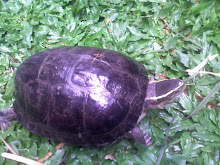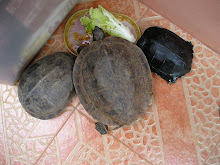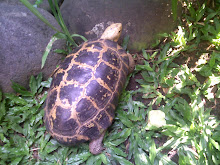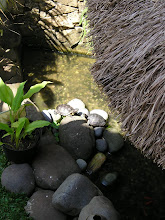By Darrell Senneke and Chris Tabaka DVM of the World Chelonian Trust
From the World Chelonian Trust website at http://www.chelonia.org
Forsten’s or the Sulawesi Tortoise belongs to the Genus Indotestudo. Included in this group are both the Elongated tortoise, Indotestudo elongata and the Travancore tortoise, Indotestudo travancorica.
Indotestudo travancorica had been considered a synonym of I. forstenii previously but is now treated as a full species1. This leads to much confusion in the literature, as one of the common names attributed to I. forstenii is the Travancore tortoise. It is the opinion of the authors as well as many taxonomists that this common name should be struck from use in connection with I. forstenii.
Other common names in use are:
Sulawesi Tortoise
Forsten's Tortoise
Celebes Tortoise
This care sheet is intended only to cover the general care of this species. Further research to best develop a maintenance / reproduction plan for whichever species you are caring for is essential.
Indotestudo forstenii is a medium sized tortoise. Typically, they are about 25 cm (10 inches) long and 2.5. kg (5 pounds) as an adult although there are larger specimens. Females tend to be wider and more rounded than males. In addition, males have a tail that is noticeably larger as well as longer than that of the female. The tip of the tail is tipped with a small keratinous hook. Males also have a slightly concave plastron while the plastron of the females are completely flat.
AppearanceThe ground color of the shell is caramel colored to dark yellowish brown, with blotches of black on each scute - this can be variable with some tortoises appearing totally caramel colored and others nearly completely black.
Forsten’s tortoise possesses a smooth shell, which appears to be remarkably resistant to the deformities often encountered in captive tortoises due to poor (high protein) diets. There has been little research on Indotestudo forstenii diets in the wild but the supposition is that their resistance to pyramiding is the result of a high humidity, moderate protein dietary adaptation.
Large scales cover the anterior parts of the front legs, while the hind legs lack this protection. The unarmored skin of this species is gray to yellow. The head is yellow /tan except in breeding season where both sexes take on a pinkish coloration around the nares and eyes.
Distribution
This species has a very limited range being found only on what was referred to as the the Celebes islands: Sulawesi and Halmahera. Sulawesi, originally named Celebes by the first Spanish and Portuguese explorers and referred to by this name by the great 17th century naturalists is historically known as an island of spices and pirates. While its very limited range appears to have protected this species to this point from the Asian food markets, this restricted range also makes it more vulnerable to habitat loss and the pet trade. The species has been placed on CITES Appendix II, which regulates legal international trade.
Natural history
Indotestudo forstenii is primarily a damp forest species though it can be found in dry areas as well. It is a crepuscular tortoise, becoming active in the twilight hours before dawn or just after sunset. Its large eyes are well adapted to low light levels. Indotestudo forstenii has an omnivorous diet in the wild consisting of fruits, leafy greens, worms, slugs and carrion if available.
Reproduction
Male I. forstenii engage in very aggressive courtship behavior which can result in injury to the female if a large enough habitat is not provided. Male aggression towards other males can also be rather damaging and it is suggested that only one male be housed per enclosure. Some large females can also be highly aggressive thus "cowing" smaller males. In courtship, the male engages in ramming behavior as well as vigorous biting about the head, neck and front legs of the female. The male loudly vocalizes during mating, emitting a harsh, raspy sound while exhaling.
A female Forsten’s tortoise preparing to nest becomes restless, often attempting to escape the enclosure. While constantly striding about the habitat, she will stop and sniff the earth from time to time as she selects a spot. Generally, the spot chosen is damp and free of vegetation. Once she has found a suitable spot, she digs a flask shaped nest 15 - 20 centimeters deep with her back legs. If the soil is too hard and dry, she will wet the spot by emptying her bladder. She then proceeds to lay a clutch of 1-4 eggs in the excavated nest, replaces the soil with her back legs and flattens the spot with her plastron. One of the author's experiences is that this species is able to hide its ova EXTREMELY well. Laying occurs in the early spring in captivity. As of the date of this article, there has been minimal captive breeding of this species in the United States.
Care in captivity
The most common form of indoor accommodation for small or medium sized Forsten’s Tortoises consists of a “turtle table’ To all appearances this looks like a bookshelf unit flipped onto its back. A reasonable size for a hatchling is 60 cm by 60 cm (2 feet by 2 feet). As the animal grows, the size of this habitat should be increased. For an adult Forsten’s tortoise the indoor accommodation should be at least 120 cm by 120 cm (4 feet by 4 feet). Into the bottom of this “turtle table” holes can be cut to allow for the sinking of food, water and eventually nesting containers flush with the surface for easier animal access.
The water area of the habitat should be large enough to allow the tortoise to soak in it if it wishes and it must also be shallow enough to protect from drowning. Photographic developing trays sunk into the surface of the habitat provide excellent water areas for adult Forsten’s tortoises. Cypress mulch is the indoor substrate of choice for this species due to its humidity retention characteristics, which in turn leads to good scute and skin health.
In one corner of the environment a 100W spot lamp should be positioned to provide artificial basking facilities. This should be positioned to provide a basking spot of 32 Degrees C (90 degrees F) or so in that section of the habitat. The habitat should also be equipped with a full spectrum fluorescent light to provide for UVB. A UVB source is necessary for Vitamin D3 syntheses (needed in calcium metabolism) If preferred to this lighting arrangement a Mercury vapor bulb may be used that fulfills all requirements. There should be a hide box located in the corner away from the basking spot to allow the animal a cool dim retreat which will be well utilized during the day.
Once nighttime temperatures stay above 15 degrees C (60 degrees F) the Forsten’s tortoises are best moved outdoors. They appear to be fairly cold tolerant and can be seen actively hunting on days when the temperature exceeds 20 degrees C (70degrees F). Forsten’s tortoises do not appreciate bright lighting and tend to hide at midday. It is suggested that one allow their pens to become overgrown, supplying them with the shady areas that they seem to require. They will also appreciate a shallow pond in their habitat, making certain to allow for ease of egress, as they frequently soak on a daily basis in warm weather. Overall, this species does best in naturally humid climates outdoors. If your area is not naturally humid, water timers and a misting/sprinkler system can be utilized to artificially create one. Some areas of the habitat should be heavily planted to allow the Forsten’s a cool dim retreat. Provision of a wet muddy area for wallowing will also be appreciated by your tortoise.
Diet
I. forstenii are omnivorous, consuming both animal and plant material in the wild. In captivity this may be duplicated by feeding a very minimal amount of low fat dog food or whole prey item twice a month. Meat should NOT be fed as a part of the daily diet. Occasional earthworms and other insects will be very much appreciated. They will also naturally forage for insects in their outdoor habitats. We have found that I. forstenii thrive on a diet supplemented with Mazuri Tortoise Diet. Wild caught animals will actively seek out yellow foods such as corn and squash which can be utilized to switch the animals over to the following diet. The diet offered should consist of:
Mazuri tortoise diet
Leafy greens (dandelions, clover, endive etc.)
Fruits
OCCASIONAL minimal meat based protein.
Diets rich in meats are invariably high in phosphates and low in calcium. This can cause serious problems for tortoises which need high levels of calcium for healthy bone and carapace development. Additional calcium supplementation is therefore highly recommended. For proper growth as well as egg production, powdered calcium can be sprinkled on all foods once a week to help meet these requirements. It is suggested that one use calcium supplemented with vitamin D3 if the animal is being maintained indoors and calcium without D3 if it is outdoors. Provision of a cuttlefish bone, which can be gnawed for it's calcium content as well as for proper beak growth, is also recommended. Usage of whole prey items as an OCCASIONAL protein source has the added benefit of providing bone for calcium as well as various vitamins and minerals in the gastrointestinal tract of the prey.
The substrate of choice is cypress mulch or something possessing the same humidity holding properties in order to keep their shells/skin from drying out in captive conditions. In outdoor pens with areas of high sand content, food should not be placed directly on sandy soil. Sand can build up in the tortoises GI tract leading to possible impaction and even death. A completely separate sand-free area in the habitat should be utilized to feed.
This species does not hibernate in nature. Facilities must be provided for the continued health and well being of the tortoise indoors in cooler (non tropical) climates. MedicalNewly imported Indotestudo forstenii invariably need medical care. This species is often exposed to a number of exotic (to it) pathogens in the shipping process (particularly during warehousing for export) and thus needs medical attention. It is often the case with this species that while they may look like they are doing well for several months, they will crash and often die from various brewing ailments if left untreated. This is a problem inherent in a number of Asian wild caught species unfortunately.
One extremely common problem that has been encountered in this species is erosive lesions in the roof of the mouth. Whenever an animal is purchased, a thorough oral examination should take place to check for said lesions. It is also wise to check for any foreign bodies as well as pneumonia/upper respiratory tract disease that often result from these lesions. While it has not yet been proven that these erosions are caused by a herpes virus, it is the most likely culprit. If an animal is purchased that has these lesions, be extremely careful about allowing the animal to live outside on grass as there have been reports of animals lost from foreign bodies lodging in these lesions and causing subsequent problems such as pneumonia. Frequent checks of the oral cavity to be sure the lesions are not spreading or impacted is recommended. Large amounts of fluids discharge and ulcerative lesions in the throat are typical.
Male Forsten's tortoises tend to be few and far between due to a higher morbidity and mortality rate than that found in the females. This is relatively common in many Asian turtles and tortoises.
Hexamita has also been encountered by one author in this species. It may be that herpes leads to a weakened immune system leading to an increased susceptibility to disease.
Last and far from least, this is one species that should be combined with another group only with EXTREME caution due to our current lack of medical ability to delineate which animals are carriers and which are clean. This makes it extremely important to reproduce this species and raise the offspring in relative isolation in order to establish clean groups, a goal that is currently being undertaken by the Turtle Survival Alliance (http://www.turtlesurvival.org/).
As dosage information available on the Internet or in hobbyist books is often dated and potentially dangerous, please work closely with your veterinarian to care for your animals.
It should be noted that turtle and tortoise care research is ongoing. As new information becomes available we share this on the World Chelonian Trust web site at http://www.chelonia.org/ /. Serious keepers find it to be a benefit to have the support of others who keep these species. Care is discussed in our free online email community, which may be joined from the web address above. Please contact us about the many benefits of becoming a member of the World Chelonian Trust
World Chelonian Trust
www.chelonia.org
PO Box 1445
Vacaville, CA
95696
Sunday, 16 August 2009
Subscribe to:
Post Comments (Atom)
































.jpg)

+085.jpg)





.jpg)
No comments:
Post a Comment